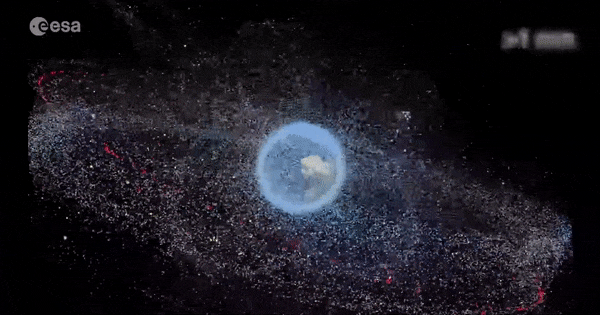Russia defends anti-satellite test amid US criticism
Russia's defense ministry says there is no threat to International Space Station crews or nearby satellites

Russia is fighting back amid criticism of its anti-satellite test Monday (Nov. 15) that forced the International Space Station crew into temporary shelter.
After the U.S. State Department condemned the anti-satellite test what it deems as "dangerous and irresponsible behavior" by Russia, a partner on the space station, officials with the Russian military are defending their launch and its effects.
Russia's Ministry of Defence also issued a Russian-language statement defending the test. The minister-general of the army, Sergei Shoigu, said that the test was successful and that "the resulting fragments do not pose any threat to space activities," according to a machine-generated translation to English.
The U.S. State Department said Monday that the test created a cloud of space debris made up of over 15,000 objects, calling it a threat to astronauts and cosmonauts, and space activities of all countries. The debris could pose a threat for years to come, experts have said. The space station's crew had to shelter in their return ships on Monday when the debris cloud was first detected.
Related: The worst space debris events of all time
Russia's space agency Roscosmos wrote on Twitter Monday that the space debris cloud "has moved away from the ISS orbit", which is roughly 250 miles (400 km) above Earth. The space debris tracker LeoLabs estimates the debris cloud is at 273 to 323 miles (440 to 520 km) in altitude. However, "the station is in the green zone," Roscosmos added.
Roscosmos also issued a website statement praising the long-time collaboration of the ISS project, which Russia reportedly was considering leaving earlier this year due to U.S. sanctions.
The @Space_Station crew is routinely performing operations according to the flight program. The orbit of the object, which forced the crew today to move into spacecraft according to standard procedures, has moved away from the ISS orbit.The station is in the green zone. pic.twitter.com/MVHVACSpmTNovember 15, 2021
"Ensuring crew safety has always been and remains our top priority. Commitment to this principle is an underlying condition both in the manufacturing of Russian space equipment and in the program of its operation," Roscosmos said in the statement, which was written in English.
Get the Space.com Newsletter
Breaking space news, the latest updates on rocket launches, skywatching events and more!
"We are convinced that only joint efforts by all spacefaring nations can ensure the safest possible coexistence and activities in outer space," Roscosmos added, noting that its own warning system on monitoring space debris is looking at the debris cloud "to prevent and counter all possible threats to the safety of the International Space Station and its crew."
In response to U.S. concerns about the orbit of the debris cloud relative to the orbit of the ISS, Russia's defense ministry said in media reports that the Americans knew there should be no concern about that.
“The U.S. knows for certain that the resulting fragments, in terms of test time and orbital parameters, did not and will not pose a threat to orbital stations, spacecraft and space activities,” Russia's Defense Ministry said, according to NBC News.
Another report from Reuters suggests the Russian defense officials launched the test in the wake of the United States establishing the Space Force military branch in 2020, and added that the United States, China and India have all performed anti-satellite tests in the past.
Space debris has been a growing threat for satellites and astronauts in orbit, with the U.S. military and other officials tracking hundreds of thousands of debris pieces from spacecraft over the years. Scientists have long warned of reaching a tipping point, known as Kessler Syndrome after the scientist Donald Kessler who first studied it, in which debris in orbit spawns even more debris in a cascade effect.
NASA Administrator Bill Nelson warned on Monday that Russia's anti-satellite test endangered not just the seven astronauts and cosmonauts on the International Space Station, but also the three-person crew of China's Tiangong space station.
"With its long and storied history in human spaceflight, it is unthinkable that Russia would endanger not only the American and international partner astronauts on the ISS, but also their own cosmonauts," Nelson said in a statement. "Their actions are reckless and dangerous, threatening as well the Chinese space station and the taikonauts on board."
“All nations have a responsibility to prevent the purposeful creation of space debris from ASATs and to foster a safe, sustainable space environment," Nelson added.
NASA did issue concerns and condemnation about resulting space debris after the Indian test of 2019 and the Chinese test of 2007. As for the 2008 incident, NASA says the destruction was meant in part to overcome the risk of an uncontrolled satellite falling to Earth.
The United States Navy's subsequent destruction of defunct spy satellite USA-193 generated falling space junk that sparked sightings in the United States and Canada, although defense officials said they recovered no debris larger than a football.
Follow Elizabeth Howell on Twitter @howellspace. Follow us on Twitter @Spacedotcom and on Facebook.
Join our Space Forums to keep talking space on the latest missions, night sky and more! And if you have a news tip, correction or comment, let us know at: community@space.com.

Elizabeth Howell (she/her), Ph.D., was a staff writer in the spaceflight channel between 2022 and 2024 specializing in Canadian space news. She was contributing writer for Space.com for 10 years from 2012 to 2024. Elizabeth's reporting includes multiple exclusives with the White House, leading world coverage about a lost-and-found space tomato on the International Space Station, witnessing five human spaceflight launches on two continents, flying parabolic, working inside a spacesuit, and participating in a simulated Mars mission. Her latest book, "Why Am I Taller?" (ECW Press, 2022) is co-written with astronaut Dave Williams.









